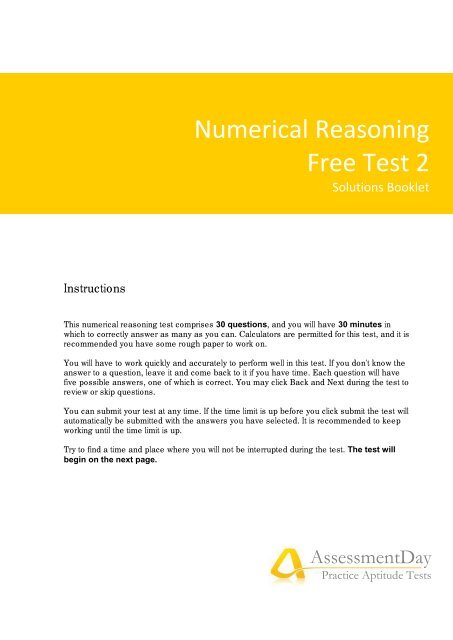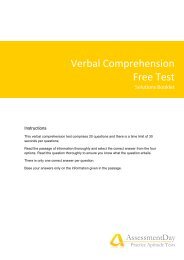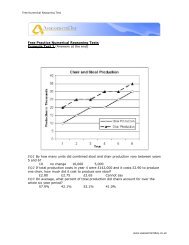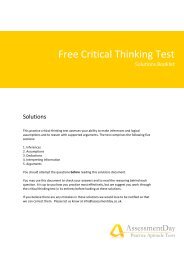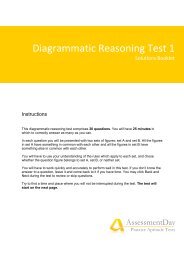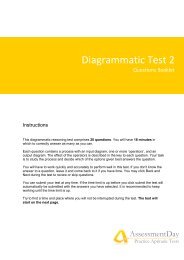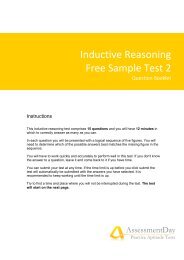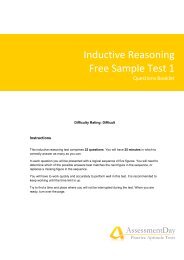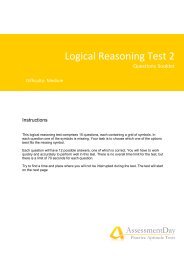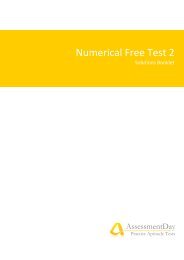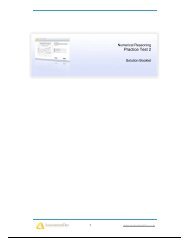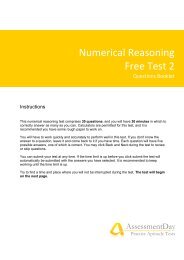Numerical Reasoning Test 2 Solutions - Aptitude Test
Numerical Reasoning Test 2 Solutions - Aptitude Test
Numerical Reasoning Test 2 Solutions - Aptitude Test
You also want an ePaper? Increase the reach of your titles
YUMPU automatically turns print PDFs into web optimized ePapers that Google loves.
<strong>Numerical</strong> <strong>Reasoning</strong><br />
Free <strong>Test</strong> 2<br />
<strong>Solutions</strong> Booklet<br />
Instructions<br />
This numerical reasoning test comprises 30 questions, and you will have 30 minutes in<br />
which to correctly answer as many as you can. Calculators are permitted for this test, and it is<br />
recommended you have some rough paper to work on.<br />
You will have to work quickly and accurately to perform well in this test. If you don't know the<br />
answer to a question, leave it and come back to it if you have time. Each question will have<br />
five possible answers, one of which is correct. You may click Back and Next during the test to<br />
review or skip questions.<br />
You can submit your test at any time. If the time limit is up before you click submit the test will<br />
automatically be submitted with the answers you have selected. It is recommended to keep<br />
working until the time limit is up.<br />
Try to find a time and place where you will not be interrupted during the test. The test will<br />
begin on the next page.<br />
AssessmentDay<br />
Practice <strong>Aptitude</strong> <strong>Test</strong>s
Q1<br />
Which company has the highest annual profit per employee?<br />
(A) A<br />
(B) B<br />
(C) C<br />
(D) D<br />
Step 1 - Simply divide the annual profit by the number of employees for each company:<br />
Company A = £4,000/employee.<br />
Company B = £3,250/employee.<br />
Company C = £2,625/employee.<br />
Company D = £1,667/employee.<br />
Tip - This is a relatively easy question; don’t waste time by looking for anything more<br />
complicated.<br />
Thus the correct answer is (A) A<br />
You may share this document with others as long<br />
as you credit AssessmentDay.co.uk with a website<br />
link however you can’t change this document in<br />
any way or use its contents commercially.<br />
Page 2<br />
AssessmentDay<br />
www.assessmentday.co.uk<br />
Document last updated 02-12-2013
Q2<br />
If the profits per employee remain the same, how many extra employees<br />
would Company B have to recruit to achieve annual profits of £39,000?<br />
(A) 6<br />
(B) 3<br />
(C) 12<br />
(D) 4<br />
Step 1 - For company B, profit per employee is originally (£26,000 ÷ 8) = £3,250/employee.<br />
So £39,000 ÷ £3,250 = 12 employees, which is 4 more than they currently have.<br />
Tip - Whilst each question can be done in isolation, it will help here if you can quickly locate<br />
the workings from the previous question.<br />
Thus the correct answer is (D) 4<br />
You may share this document with others as long<br />
as you credit AssessmentDay.co.uk with a website<br />
link however you can’t change this document in<br />
any way or use its contents commercially.<br />
Page 3<br />
AssessmentDay<br />
www.assessmentday.co.uk<br />
Document last updated 02-12-2013
Q3<br />
If every employee of Company D contributes equally, how much would each<br />
employee have to contribute in order to collectively buy Company A?<br />
(A) £1,000<br />
(B) £1,500<br />
(C) £1,700<br />
(D) £2,700<br />
Step 1 - We are told that the cost to buy Company A is £18,000. We are also told there are<br />
18 employees in Company D. So £18,000 ÷ 18 employees = £1,000 per person.<br />
Thus the correct answer is (A) £1,000<br />
You may share this document with others as long<br />
as you credit AssessmentDay.co.uk with a website<br />
link however you can’t change this document in<br />
any way or use its contents commercially.<br />
Page 4<br />
AssessmentDay<br />
www.assessmentday.co.uk<br />
Document last updated 02-12-2013
Q4<br />
Between 1990 and 2000, what was the increase in energy use for the PC<br />
Room, Meeting Rooms and Office Space combined?<br />
(A) 50kWh<br />
(B) 184kWh<br />
(C) 188kWh<br />
(D) Cannot say<br />
Step 1 - The graphs give percentages, with the total shown at the bottom. Don’t waste time<br />
by working out the kWh value for each of the PC Room, the Meeting Rooms and the Office<br />
Space. Use the percentages and add up at the end:<br />
In 1990: (12% + 12% + 41%) of 17,000kWh = 11,050kWh<br />
In 2000: (21% + 14% + 39%) of 15,000kWh = 11,100kWh.<br />
Which is an increase of 50kWh.<br />
Thus the correct answer is (A) 50kWh<br />
You may share this document with others as long<br />
as you credit AssessmentDay.co.uk with a website<br />
link however you can’t change this document in<br />
any way or use its contents commercially.<br />
Page 5<br />
AssessmentDay<br />
www.assessmentday.co.uk<br />
Document last updated 02-12-2013
Q5<br />
If the Building Energy Use today is 6% less than it was in 2000, by what<br />
percentage is today’s Building Energy Use lower than that of 1990?<br />
(A) 82.9%<br />
(B) 17.1%<br />
(C) 17.8%<br />
(D) Cannot say<br />
Step 1 - Total energy usage in 2000 = 15,000kWh, so today’s at 6% less is 15,000 x 0.94 =<br />
14,100kWh. This compares with 1990 levels of 17,000kWh.<br />
Step 2 - To work out the reduction from 17,000 to 14,100, calculate (14,100 ÷ 17,000) =<br />
0.8294, which is a reduction of (1-0.8294 = 0.17059) 17.1%.<br />
Thus the correct answer is (B) 17.1%<br />
You may share this document with others as long<br />
as you credit AssessmentDay.co.uk with a website<br />
link however you can’t change this document in<br />
any way or use its contents commercially.<br />
Page 6<br />
AssessmentDay<br />
www.assessmentday.co.uk<br />
Document last updated 02-12-2013
Q6 Which space experienced the smallest reduction in kWh used between 1990<br />
and 2000?<br />
(A) Office Space<br />
(B) Print Room<br />
(C) Meeting Rooms<br />
(D) PC Room<br />
Step 1 - We can rule out the PC Room from the possible answers by inspection since it is<br />
apparent its energy use actually increased between 1990 and 2000.<br />
Step 2 - So the other three possible answers:<br />
Print Room: 2,550 – 1,800 = 750kWh.<br />
Office Space: 6,970 – 5,850 = 1,120kWh.<br />
Meeting Rooms: 2,040 – 2,100 = Increase of 60kWh (note question asked for smallest<br />
reduction).<br />
Thus the correct answer is (B) Print Room<br />
You may share this document with others as long<br />
as you credit AssessmentDay.co.uk with a website<br />
link however you can’t change this document in<br />
any way or use its contents commercially.<br />
Page 7<br />
AssessmentDay<br />
www.assessmentday.co.uk<br />
Document last updated 02-12-2013
Q7<br />
Approximately what percentage of the people sampled are unemployed?<br />
(A) 7%<br />
(B) 5%<br />
(C) 6%<br />
(D) 4%<br />
Step 1 - Make sure you add together the male and female figures to arrive at a figure for<br />
‘people’.<br />
Total number unemployed = 52,000 + 43,000 = 95,000.<br />
Step 2 - Total number people sampled = 1,343,000 + 1,031,000 = 2,374,000.<br />
Step 3 - So now 95,000 ÷ 2,374,000 = 4%.<br />
Thus the correct answer is (D) 4%<br />
You may share this document with others as long<br />
as you credit AssessmentDay.co.uk with a website<br />
link however you can’t change this document in<br />
any way or use its contents commercially.<br />
Page 8<br />
AssessmentDay<br />
www.assessmentday.co.uk<br />
Document last updated 02-12-2013
Q8 If it is predicted that the number of females employed in IT will rise by 10%<br />
every year, but the number of males stays the same, what percent of IT<br />
employees would be female after a three year period?<br />
(A) 54.1%<br />
(B) 53.5%<br />
(C) 85.0%<br />
(D) 45.5%<br />
Step 1 - Number of female IT employees to start with is 107,000 from the table.<br />
Step 2 - If the number of female employees rises by 10%, that gives 142,417 employees after<br />
three years (107,000 x 1.10 x 1.10 x 1.10 = 142,417).<br />
Step 3 - The number of male IT employees is still 121,000, so the total in IT is now 142,417 +<br />
121,000 = 263,417. So 142,417 out of 263,417 IT employees is 54.07%.<br />
Tip - With this question, where we are dealing with number of people, you should end up with<br />
integers in the working since it is not possible to have part of a person. If you start to get<br />
decimals, consider whether you have made a mistake.<br />
Thus the correct answer is (A) 54.1%<br />
You may share this document with others as long<br />
as you credit AssessmentDay.co.uk with a website<br />
link however you can’t change this document in<br />
any way or use its contents commercially.<br />
Page 9<br />
AssessmentDay<br />
www.assessmentday.co.uk<br />
Document last updated 02-12-2013
Q9<br />
What was the average accident cost per vehicle on the road in Ribley in<br />
November?<br />
(A) £0.23<br />
(B) £0.47<br />
(C) £15.40<br />
(D) £2.30<br />
Step 1 - Hopefully you have noticed that the ‘Vehicles on Road’ figures are in thousands.<br />
Total average cost of accidents in Ribley in November = 10 x £1,900 = £19,000. Number of<br />
vehicles on road = 81,000. So £19,000 ÷ 81,000 = £0.2346.<br />
Tip - Don’t be fooled into thinking the answer is simply the ‘Average cost per accident’ figure<br />
given on the right hand side; per vehicle on the road is what the question is after. If it looks as<br />
though all you have to do for a question is read a number from the figure, you have probably<br />
misunderstood.<br />
Thus the correct answer is (A) £0.23<br />
You may share this document with others as long<br />
as you credit AssessmentDay.co.uk with a website<br />
link however you can’t change this document in<br />
any way or use its contents commercially.<br />
Page 10<br />
AssessmentDay<br />
www.assessmentday.co.uk<br />
Document last updated 02-12-2013
Q10<br />
Comparing Wartop with Surren, what was the difference in average accident<br />
cost per vehicle on the road in October?<br />
(A) 3.4p<br />
(B) 6.4p<br />
(C) £64.60<br />
(D) £0.70<br />
Step 1 - The working is similar to the previous question, but there is a but more work to this<br />
question as you have to work it out for two towns. Again, don’t forget that the ‘Vehicles on<br />
Road’ figure is in thousands. The fact that the question asks for ‘average accident cost’<br />
means we can answer the question because we are given the ‘Average cost per accident’<br />
figure to apply to all accidents. Otherwise we’d have to know the cost of every single accident.<br />
Wartop: (£3,200 per accident x 4 accidents) ÷ 89,000 vehicles on road = (12,800) ÷ 89,000 =<br />
£0.1438.<br />
Surren: (£1,050 per accident x 9 accidents) ÷ 119,000 vehicles on road = (9,450) ÷ 119,000 =<br />
£0.0794.<br />
Step 2 - Difference = £0.064.<br />
Thus the correct answer is (B) 6.4p<br />
You may share this document with others as long<br />
as you credit AssessmentDay.co.uk with a website<br />
link however you can’t change this document in<br />
any way or use its contents commercially.<br />
Page 11<br />
AssessmentDay<br />
www.assessmentday.co.uk<br />
Document last updated 02-12-2013
Q11<br />
The only towns in the County are Ribley, Wartop and Surren. What was the<br />
average accident cost per vehicle on the road in September for the County?<br />
(A) £0.17<br />
(B) £0.32<br />
(C) £0.94<br />
(D) £20.50<br />
Tip - Don’t be fooled into working out the average accident cost per vehicle on road for all<br />
three towns, and then finding the average of these by summing and dividing by three. This is<br />
not the overall average, this would give a distorted average toward the town with the lowest<br />
number of accidents.<br />
Step 1 - We need to first find the total costs of all accidents for all towns: (£1,900 x 6) +<br />
(£3,200 x 18) + (£1,050 x 20) = £90,000.<br />
Step 2 - Now divide this by the total number of vehicles on the road for all three towns<br />
(76,000 + 101,000 + 104,000) = 281,000.<br />
Step 3 - So £90,000 ÷ 281,000 = £0.320.<br />
Thus the correct answer is (B) £0.32<br />
You may share this document with others as long<br />
as you credit AssessmentDay.co.uk with a website<br />
link however you can’t change this document in<br />
any way or use its contents commercially.<br />
Page 12<br />
AssessmentDay<br />
www.assessmentday.co.uk<br />
Document last updated 02-12-2013
Q12 In 1996, total output from all fuels was 200TWh. If output for Nuclear in 2006<br />
was twice that for Coal in 1996, what was the output for Nuclear in 2006?<br />
(A) 140TWh<br />
(B) 400TWh<br />
(C) 64TWh<br />
(D) 96TWh<br />
Tip - If you read this quickly, it might be daunting. It needn’t be if you take each step at a time.<br />
Step 1 - We are told that the total output from all fuels in 1996 is 200TWh, so we can work out<br />
what is was for coal in 1996.<br />
Coal in 1996 was 35% of 200TWh: 70TWh. So Nuclear in 2006 is twice this: 140TWh.<br />
Thus the correct answer is (A) 140TWh<br />
You may share this document with others as long<br />
as you credit AssessmentDay.co.uk with a website<br />
link however you can’t change this document in<br />
any way or use its contents commercially.<br />
Page 13<br />
AssessmentDay<br />
www.assessmentday.co.uk<br />
Document last updated 02-12-2013
Q13<br />
If between 1996 and 2006, Renewables output doubled to 18TWh,<br />
approximately what was the Gas output in 1996?<br />
(A) 129TWh<br />
(B) 86TWh<br />
(C) 120TWh<br />
(D) 110TWh<br />
Tip - Again, work through each step using what we have been told. Bear in mind you never<br />
need information that was given in the previous question; each question should stand alone.<br />
Step 1 - So in 2006 we are told Renewables was 18TWh, which was double what it was in<br />
1996: 9TWh.<br />
Step 2 - Therefore, if 9TWh is 3% of the total (according to chart), the total in 1996 was<br />
300TWh (9TWh ÷ 0.03 = 300TWh). Gas we are told made up 43% in 1996, i.e. 0.43 x<br />
300TWh = 129TWh.<br />
Thus the correct answer is (A)129TWh<br />
You may share this document with others as long<br />
as you credit AssessmentDay.co.uk with a website<br />
link however you can’t change this document in<br />
any way or use its contents commercially.<br />
Page 14<br />
AssessmentDay<br />
www.assessmentday.co.uk<br />
Document last updated 02-12-2013
Q14<br />
If total output was 200TWh in 1996 and 320TWh in 2006, what was Gas<br />
output in 2001?<br />
(A) 107TWh<br />
(B) 133TWh<br />
(C) 120TWh<br />
(D) Cannot say<br />
This is a fairly obvious ‘cannot say’ question. Don’t try to extrapolate between 1996 and 2000<br />
since we are not told what the trend was. No data is given, or can be implied, for 2001 in the<br />
question. Often, it is less obvious that the answer cannot be determined from the available<br />
information.<br />
Thus the correct answer is (D) Cannot say<br />
You may share this document with others as long<br />
as you credit AssessmentDay.co.uk with a website<br />
link however you can’t change this document in<br />
any way or use its contents commercially.<br />
Page 15<br />
AssessmentDay<br />
www.assessmentday.co.uk<br />
Document last updated 02-12-2013
Q15<br />
This year saw a 20% increase in the total number of refunds over last year.<br />
Approximately how many refunds were issued this year due to Delivery<br />
Damage?<br />
(A) 102<br />
(B) 104<br />
(C) 124<br />
(D) 1040<br />
Step 1 - Total refunds last year: 912, so for this year add 20% by multiplying 912 by 1.2 which<br />
comes to 1094.4.<br />
Step 2 - Of these 1094.4 refunds, we are told from the table 9.5% were refunded due to<br />
delivery damage. So 0.095 x 1094.4 = 103.97. The fact that the questions asks for an<br />
‘approximate’ number of refunds means our decimal place answer for what can be only an<br />
integer is OK (in fact it should encourage us because an integer answer would not ask for an<br />
‘approximate’ number in the question.)<br />
Thus the correct answer is (B) 104<br />
You may share this document with others as long<br />
as you credit AssessmentDay.co.uk with a website<br />
link however you can’t change this document in<br />
any way or use its contents commercially.<br />
Page 16<br />
AssessmentDay<br />
www.assessmentday.co.uk<br />
Document last updated 02-12-2013
Q16<br />
The number of refunds last year due to Faulty Hardware was an increase of<br />
15% above the year before last. Approximately how many complaints were<br />
received from Faulty Hardware in the year before last?<br />
(A) 186<br />
(B) 215<br />
(C) 325<br />
(D) 343<br />
Step 1 - Start with the total for last year: 912.<br />
Step 2 - From the table we see that 41% of these were due to Faulty Hardware, so we know<br />
that last year there were (0.41 x 912 =) 373.92 refunds due to Faulty Hardware.<br />
Step 3 - Now, we are told in the passage that this figure is a 15% increase above the year<br />
before last. So 373.92 ÷ 1.15 = 325.15 will be the number of refunds for the year before last.<br />
Thus the correct answer is (C) 325<br />
You may share this document with others as long<br />
as you credit AssessmentDay.co.uk with a website<br />
link however you can’t change this document in<br />
any way or use its contents commercially.<br />
Page 17<br />
AssessmentDay<br />
www.assessmentday.co.uk<br />
Document last updated 02-12-2013
Q17<br />
If the total number of refunds this year was 840, by what percentage did<br />
Faulty Hardware refunds increase between last year and this year?<br />
(A) 7.8%<br />
(B) 2.8%<br />
(C) 79.1%<br />
(D) 11.0%<br />
Step 1 - This one is a fairly straight forward application of percentages.<br />
Last year = 912 x 41% = 373.9<br />
This year = 840 x 48% = 403.2<br />
Therefore increase = 403.2 ÷ 373.9 = 1.0784, which is an increase of 7.84%.<br />
Thus the correct answer is (A) 7.8%<br />
You may share this document with others as long<br />
as you credit AssessmentDay.co.uk with a website<br />
link however you can’t change this document in<br />
any way or use its contents commercially.<br />
Page 18<br />
AssessmentDay<br />
www.assessmentday.co.uk<br />
Document last updated 02-12-2013
Q18<br />
What was the approximate value in Pounds Sterling of 150 Canadian Dollars<br />
in May 2004?<br />
(A) £55<br />
(B) £75<br />
(C) £130<br />
(D) £300<br />
Step 1 - The table shows us that 1 Canadian Dollar is worth 0.5 Pounds Sterling. So 150<br />
CAD x 0.5 = £75.<br />
Thus the correct answer is (B) £75<br />
Q19 Approximately how many Euros was 85 Russian Rubles worth in May 2004?<br />
(A) Є2.46<br />
(B) Є2,933<br />
(C) Є1,900<br />
(D) Cannot say<br />
You have to convert both Euros and Rubles to a common reference (we’ll use Pounds). So<br />
for 85 Rubles; 85 x 0.020 = £1.7. We are told one Euro is worth £0.69, so £1.7 must be worth<br />
€2.464.<br />
Thus the correct answer is (A) Є2.46<br />
You may share this document with others as long<br />
as you credit AssessmentDay.co.uk with a website<br />
link however you can’t change this document in<br />
any way or use its contents commercially.<br />
Page 19<br />
AssessmentDay<br />
www.assessmentday.co.uk<br />
Document last updated 02-12-2013
Q20<br />
In May 2004 approximately how many more Canadian Dollars would you have<br />
got for 100 UK Pounds Sterling than you would for 120 US Dollars?<br />
(A) CAD$35<br />
(B) CAD$54<br />
(C) CAD$60<br />
(D) CAD$62<br />
Step 1 - 100 Pounds = 200 CAD (100 ÷ 0.5).<br />
Step 2 - 120 US Dollars = 137.93 CAD (120 ÷ 0.87).<br />
Step 3 - So the difference is 200– 137.93 = 62.07 CAD.<br />
Thus the correct answer is (D) CAD$62<br />
You may share this document with others as long<br />
as you credit AssessmentDay.co.uk with a website<br />
link however you can’t change this document in<br />
any way or use its contents commercially.<br />
Page 20<br />
AssessmentDay<br />
www.assessmentday.co.uk<br />
Document last updated 02-12-2013
Q21 How many cars under 2,000kg were there in France in 1995?<br />
(A) 918,000<br />
(B) 918<br />
(C) 408,000<br />
(D) 737,000<br />
Step 1 - Simply add up the number of cars in each bracket up to 1,999kg. There’s also a little<br />
thing to look out for which is that these figures are all in thousands. So 510 + 346 + 56 + 6<br />
(thousand) = 918,000.<br />
Thus the correct answer is (A) 918,000<br />
You may share this document with others as long<br />
as you credit AssessmentDay.co.uk with a website<br />
link however you can’t change this document in<br />
any way or use its contents commercially.<br />
Page 21<br />
AssessmentDay<br />
www.assessmentday.co.uk<br />
Document last updated 02-12-2013
Q22 What was the combined mass of all the cars in the UK in 2000?<br />
(A) 211,000kg<br />
(B) 858,500kg<br />
(C) 1,426,500kg<br />
(D) Cannot Say<br />
You might be tempted to do something like multiply the number of cars in each range by their<br />
average weight, or something similar. Don’t; read the question carefully. Because the data is<br />
grouped, we don’t know how many cars are at the bottom end of the group, and how many<br />
are towards the top. It is impossible to say from the data given.<br />
Thus the correct answer is (D) Cannot Say<br />
You may share this document with others as long<br />
as you credit AssessmentDay.co.uk with a website<br />
link however you can’t change this document in<br />
any way or use its contents commercially.<br />
Page 22<br />
AssessmentDay<br />
www.assessmentday.co.uk<br />
Document last updated 02-12-2013
Q23<br />
In the UK, what was the percentage increase in the total number of cars<br />
between 1995 and 2000?<br />
(A) 15.0%<br />
(B) 16.6%<br />
(C) 32.1%<br />
(D) 58.0%<br />
You have to find the sum of the number of cars in 1995, do the same for 2000, and work out<br />
the percentage difference between the two.<br />
Step 1 - In 1995: 4 + 21 + 292 + 420 + 71 = 808 (thousand)<br />
Step 2 - In 2000: 9 + 32 + 341 + 495 + 65 = 942 (thousand)<br />
Step 3 - So the percentage increase was 942 ÷ 808 = 1.166 = 16.6%.<br />
Thus the correct answer is (B) 16.6%<br />
You may share this document with others as long<br />
as you credit AssessmentDay.co.uk with a website<br />
link however you can’t change this document in<br />
any way or use its contents commercially.<br />
Page 23<br />
AssessmentDay<br />
www.assessmentday.co.uk<br />
Document last updated 02-12-2013
Q24<br />
How many live births occurred in 1985 in Greece and Australia combined?<br />
(A) 21,200<br />
(B) 748,200<br />
(C) 1,051,000<br />
(D) Cannot say<br />
Note live births are given per 1,000 population.<br />
Step 1 - So considering each country we have:<br />
Greece: 28.5 (million) x 13.2 (per 1000). The best way to rationalise the units is to say this is<br />
equivalent to 28,500 x 13.2 which = 376,200.<br />
Step 2 - And the same with Australia: 46.5 (million) x 8.0 (per 1000) = 372,000.<br />
Step 3 - Add these together and the total is 748,200.<br />
Thus the correct answer is (B) 748,200<br />
You may share this document with others as long<br />
as you credit AssessmentDay.co.uk with a website<br />
link however you can’t change this document in<br />
any way or use its contents commercially.<br />
Page 24<br />
AssessmentDay<br />
www.assessmentday.co.uk<br />
Document last updated 02-12-2013
Q25<br />
Which country had the highest number of people aged under 15 at the start of<br />
1985?<br />
(A) UK<br />
(B) France<br />
(C) Australia<br />
(D) Germany<br />
Immediately from the possible answers we can neglect Greece in our working.<br />
Step 1 - But we have to work out the number of people under 15 for the other countries,<br />
although we don’t need to bother with the units since the question asks only for the largest in<br />
magnitude.<br />
UK: 56.6 x 19% = 10.754<br />
France: 55.2 x 21% = 11.592<br />
Australia: 46.5 x 19% = 8.835<br />
Germany: 61.0 x 15% = 9.15<br />
Thus the correct answer is (B) France<br />
You may share this document with others as long<br />
as you credit AssessmentDay.co.uk with a website<br />
link however you can’t change this document in<br />
any way or use its contents commercially.<br />
Page 25<br />
AssessmentDay<br />
www.assessmentday.co.uk<br />
Document last updated 02-12-2013
Q26 What was the net effect on the UK population in 1985?<br />
(A) Increase of 84,900<br />
(B) Increase of 85,170<br />
(C) Increase of 542,810<br />
(D) Decrease of 61,400<br />
We have to consider the births and deaths and find the net effect.<br />
Step 1 - Births: 13.3 (per 1000) x 56.6 (million) = 752,780.<br />
Step 2 - Deaths: 11.8 (per 1000) x 56.6 (million) = 667,880.<br />
Step 3 - So the net increase is 84,900.<br />
Thus the correct answer is (A) 84,900<br />
You may share this document with others as long<br />
as you credit AssessmentDay.co.uk with a website<br />
link however you can’t change this document in<br />
any way or use its contents commercially.<br />
Page 26<br />
AssessmentDay<br />
www.assessmentday.co.uk<br />
Document last updated 02-12-2013
Q27<br />
Approximately what percentage of the German population were aged 60 or<br />
over at the end of 1985?<br />
(A) 20%<br />
(B) 21%<br />
(C) 16%<br />
(D) Cannot Say<br />
The end column giving percent over 60 is for the start of the year only. By the end of the year,<br />
this will certainly have changed but we are not told what the figure is.<br />
Thus the correct answer is (D) Cannot Say<br />
You may share this document with others as long<br />
as you credit AssessmentDay.co.uk with a website<br />
link however you can’t change this document in<br />
any way or use its contents commercially.<br />
Page 27<br />
AssessmentDay<br />
www.assessmentday.co.uk<br />
Document last updated 02-12-2013
Q28<br />
For the four shops combined, which of the months shown saw the largest<br />
decrease in number of PC sales compared to the previous month?<br />
(A) Feb<br />
(B) Mar<br />
(C) Apr<br />
(D) Cannot say<br />
Step 1 - Sometimes it is possible to rule out some of the possible answers just by looking at<br />
the figure, but for this question that is quite difficult. We have to sum for every month:<br />
Jan: 8 + 20 + 5 + 10 = 43<br />
Feb: 10 + 20 + 4 + 14 = 48<br />
Mar: 13 + 18 + 6 + 18 = 55<br />
Apr: 10 + 16 + 8 + 19 = 53<br />
April was the only month where sales dropped from levels of the previous month.<br />
Note the question said for “the months shown”. This is important because otherwise we<br />
wouldn’t be able to tell without being given sales figures for May – December.<br />
Thus the correct answer is (C) April<br />
You may share this document with others as long<br />
as you credit AssessmentDay.co.uk with a website<br />
link however you can’t change this document in<br />
any way or use its contents commercially.<br />
Page 28<br />
AssessmentDay<br />
www.assessmentday.co.uk<br />
Document last updated 02-12-2013
Q29<br />
Approximately what percentage of Regal PC’s sales were made in April?<br />
(A) 21%<br />
(B) 22%<br />
(C) 24%<br />
(D) 28%<br />
This is a fairly straightforward percentage question.<br />
Step 1 - Total PC sales for Regal in the data given = 8 + 10 + 13 + 10 = 41.<br />
Sales in April = 10.<br />
Step 2 - So 10 ÷ 41 = 24.4%.<br />
Thus the correct answer is (C) 24<br />
You may share this document with others as long<br />
as you credit AssessmentDay.co.uk with a website<br />
link however you can’t change this document in<br />
any way or use its contents commercially.<br />
Page 29<br />
AssessmentDay<br />
www.assessmentday.co.uk<br />
Document last updated 02-12-2013
Q30<br />
If the average profit made on each PC sold by Quick PC was £62, what was<br />
the total profit over the four months for Quick PC?<br />
(A) £3,144<br />
(B) £3,782<br />
(C) £3,857<br />
(D) Cannot say<br />
Step 1 - Total sales by Quick PC over the four months = 10 + 14 + 18 + 19 = 61.<br />
Step 2 - So 61 x £62 = £3,782.<br />
Thus the correct answer is (B) £3,782<br />
-- End of <strong>Test</strong> --<br />
For more numerical reasoning tests visit AssessmentDay.co.uk<br />
You may share this document with others as long<br />
as you credit AssessmentDay.co.uk with a website<br />
link however you can’t change this document in<br />
any way or use its contents commercially.<br />
Page 30<br />
AssessmentDay<br />
www.assessmentday.co.uk<br />
Document last updated 02-12-2013


